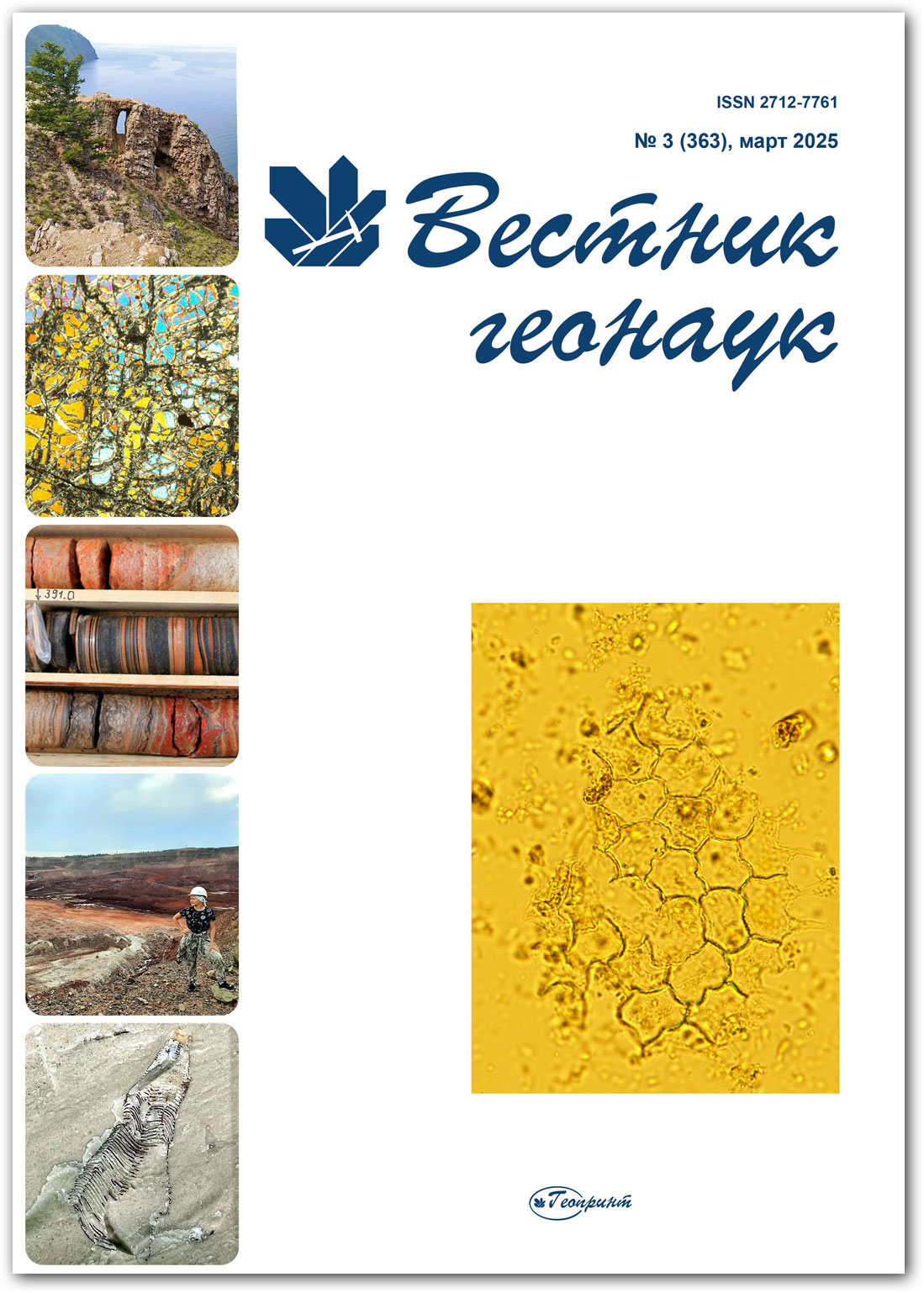|
On the cover: green alga Pediastrum boryanum var. longicorne from the sediments of a paleolake that existed
14,000 years ago in the lower reaches of the Seida River (Vorkuta District, Komi Republic). Shot with 500x zoom.
Photo by Yu. Golubeva
|
|
| |
|
|
 Title page Title page
|
1
|
|
 Content Content
|
2
|
| |
|
|
|
|
Scientific articles
|
|
Composition of hydrocarbons-biomarkers of bitumoids of different-aged deposits
of the Timan-Pechora and Volga-Ural oil and gas provinces
L. Kh. Galiakhmetova, R. A. Markelov, R. E. Mukhamatdinova, I. I. Mukhamatdinov, A. V. Vakhin
DOI: 10.19110/geov.2025.3.1
The study presents the results of hydrocarbon biomarker analysis in bitumoids extracted from Middle Devonian Eifelian rocks of the Yarega field and Permian-Carboniferous deposits of the Usinsk field in the Timan-Pechora petroleum province. It also examines bitumoids from Upper Permian Ufimian rocks of the Ashalcha and Mordovo-Karmal fields in the Volga-Ural petroleum province using a comprehensive geochemical approach. The analyzed biomarker group includes normal and isoprenoid alkanes, aromatic compounds, and cyclic isoprenoids such as steranes and triterpanes. Key geochemical parameters were determined on the basis of paraffinic, aromatic, sterane, and hopane hydrocarbons. A comparative analysis revealed similar sedimentary environments and a consistent type of original organic matter across the studied deposits. This suggests a marine origin of the original organic material, which accumulated and underwent diagenetic transformation under reducing conditions. The thermal maturity of the organic matter corresponds to the main phase of oil generation.
Keywords: bitumoid, chemofossils, biomarkers, hopanes, steranes, hydrocarbons
 Download full text Download full text
|
3—10
|
Update of oil and gas potential of Permian deposits in the junction zone
of Vilyui syneclise and the Aldan anteclise
M. M. Takhvatulin
DOI: 10.19110/geov.2025.3.2
Over the past two decades, significant geological exploration work, including seismic exploration, has been carried out within the junction zone of the Vilyui syneclise and the Aldan anteclise. In addition, oil and gas companies are also interested in this territory, acquiring licenses for the search and exploration for hydrocarbon deposits. The object of the study is the terrigenous deposits of the Permian system. The main oil and gas potential of this territory is associated with these Permian deposits. Within the Vilyui syneclise, there are gas fields in the Permian deposits, which provide gas to the central regions of Yakutia. Thus, it is necessary to update the oil and gas potential of the area. The study was based on seismic exploration data, deep well data, including well logging curves, core descriptions, and Permian sediment test results. Previously published literature on the geological structure of Permian rocks was also analyzed. Our seismic interpretation and analysis of well data resulted in structural surfaces. The structural surfaces characterize Permian, Triassic and Jurassic sediments. The thickness maps have been used to determine the distribution areas of Permian deposits, Triassic and Jurassic fluid-sealing rocks. Using structural maps, thickness maps, faults and well data, the most oil and gas promising zones and objects of Permian deposits were identified. The promising zones are associated with a reduction in the thickness of Permian deposits, and identified near the wedge line. The fault-limited positive structures are promising objects.
Keywords: Siberian platform, Vilyui syneclise, Aldan anteclise, Permian deposits, taragay formation, seismic surveys, oil and gas potential
 Download full text Download full text
|
11—24
|
Specifics of the distribution of rare-earth and rare elements in the weathering crusts
of the Nem and Zhezhimparma uplands at the Southern Timan
O. V. Grakova, K. S. Popvasev
DOI: 10.19110/geov.2025.3.3
The article presents the results of the study of the distribution of rare earth and trace elements in the weathering crusts of the Southern Timan, differing in age and bedding conditions, in the Dzhezhim and Asyvvozh quarries on the Zhezhimparma Upland and in the Vadyavozh quarry on the Nem Upland. On the Zhezhimparma Upland, a similarity of the geochemical characteristics of sandstones and clayey rocks at the base of the Devonian section was obsered, confirming the tectonic origin of the clayey formations previously considered to be the weathering crust. In the Vadyavozh quarry, a geochemical analysis was conducted on Mesozoic-Cenozoic areal and linear weathering crusts developed over basement rocks. The study confirmed a genetic link between the micaceous aleurolites of the Upper Riphean Dzhezhim suite and the Riphean weathering crust formation.
Keywords: Southern Timan, Dzhezhim suite, weathering crust, rare earth and trace elements
 Download full text Download full text
|
25—33
|
Formation of Holocene sediments in the lower reach of the Chernaya River
(northwest of the Bolshezemelskaya tundra)
V. A. Isakov
|
34—46
|
New data on stromatoporoids of the Northern Pai-Khoi Upper Devonian Lymbada Formation
E. V. Antropova
|
47—53 |
|
|
| |
|
|
Chronicle, events, facts
|
|
| |
|
|
Researcher of the Earth subsoil and his concept of subsoil use.
On the occasion of the 90th Anniversary of the birth of Yuri Andreevich Tkachev (19.03.1935—01.10.2020)
 Download full text Download full text
|
54—56 |
|
|













